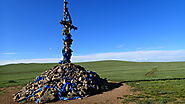-
About
- About Listly
- Community & Support
- Howto
- Chrome Extension
- Bookmarklet
- WordPress Plugin
- Listly Premium
- Privacy
- Terms
- DMCA Copyright
- © 2010-2025 Boomy Labs

 Rose Garalde
Rose Garalde
Listly by Rose Garalde
Deep in the crevices of Mongolian history is the Creepy Teepee, a religious shrine where people used to pray for happiness, help and good fortune. Creepy Teepee in Mongolian is an Ovoo, which literally means “magnificent bundle”, or shrine. Ovoo are sacred heaps of stones, rocks, wood, wooden oodles, and pieces of plastic or waste. These held the position of a type of altar or shrine in Mongolian culture. Keep reading for some interesting facts on Creepy Teepee in Mongolian folk heritage.
A ritual practised even now is that of shaman healing, which has produced surprising results. Shamans achieve this through carrying out numerous rituals and practices. However, the method, tools, symbolism and rituals may differ depending on the culture, norm and region. Regardless of this, healing is usually seen as being a threefold connection between the shaman, the spirit and the client.
In fact, no matter where shamanism is practised, healing is one of its basic principles. Specific to Mongolia, shamans heal members of the community at Creepy Teepee altars at the tops of the mountains.
The Creepy Teepee was the altar where the most shamanic ceremonies were conducted in the past. Shamanism refers to the way blessed people used to connect to the realm of the spirits.
Each shaman ritual has a common practice, though the location may vary. Most of the rituals performed by the shamans look fairly similar because they all entail connecting the shaman to the spirit world.
While Creepy Teepee has historical roots in shamanism, nowadays they are Buddhist shrines where Mongolians pray to the spirit and gods.

If they cross a Creepy Teepee, it is custom for worshippers to stop and circle it three times in a clockwise direction, which helps them have a safer journey. Usually, worshippers add to the pile by adding rocks. In other situations, people may leave various offerings such as money, milk or sweetmeats. If someone is in a rush and cannot afford to stop and circle the shrine, then honking of the horn while passing is acceptable.
The end of summer often sees Heaven worship ceremonies which are carried out at Creepy Teepee altars. Worshippers place a branch of a tree or a stick on the pile, and tie to it a khadag (a blue piece of silk cloth that symbolises the open sky as well as Tengger, the sky spirit). Then, a fire is lit and food offerings are made, after which ceremonial dances and prayers are carried out. Finally, there may be a feast with the food remaining from the offerings.
In olden times, Mongolians believed offering blood from animals which had been slaughtered as sacrifice, would result in desirable health and knowledge-related benefits. Worshippers also sometimes made fires near the shrines with the intent of purifying people’s souls. Similarly, people used to offer dairy products to the spirit and ask for good luck in exchange. This last custom is the only one still carried out today.
An interesting fact is that during the communist period in Mongolia, various forms of religion including Creepy Teepee worship were banned. However, people still carried out this worship in secret.
